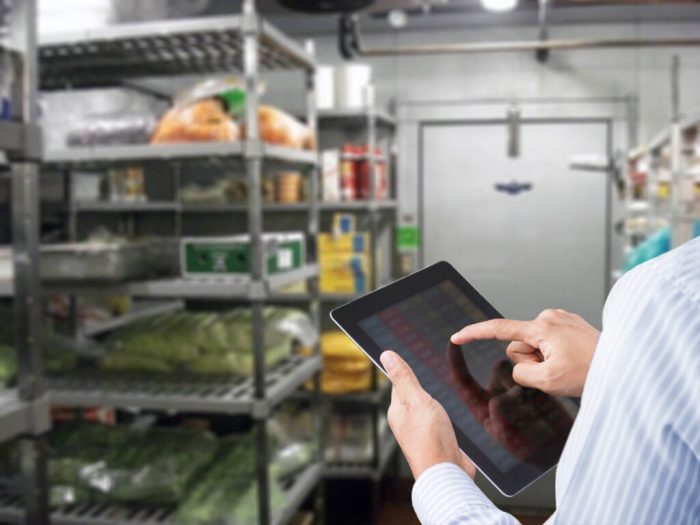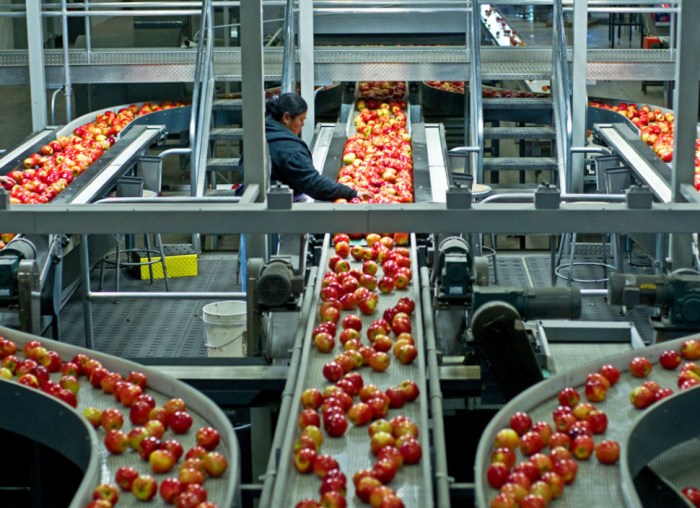FOOD PRODUCTION MANAGEMENT SOFTWARE: Streamlining Efficiency and Quality
Originally posted 2024-09-25 20:00:00.
FOOD PRODUCTION MANAGEMENT SOFTWARE is revolutionizing the food industry by offering powerful tools to optimize operations, enhance efficiency, and ensure quality control. From managing production schedules and inventory to tracking ingredients and ensuring compliance with food safety regulations, these software solutions are essential for modern food businesses.
The challenges faced in food production are multifaceted. Managing complex production processes, maintaining accurate inventory records, adhering to strict food safety standards, and ensuring traceability throughout the supply chain can be daunting tasks. Food production management software addresses these challenges by providing a centralized platform for managing all aspects of the food production process, from raw material procurement to finished product delivery.
Introduction
Food production management software is an essential tool in today’s complex and demanding food industry. It plays a crucial role in optimizing processes, improving efficiency, and ensuring food safety, ultimately contributing to the sustainability and profitability of food businesses.The food industry faces numerous challenges, including:
Challenges in Food Production
Food production involves intricate processes that require careful management to maintain quality, safety, and efficiency. Some key challenges include:
- Managing Complex Supply Chains:Food production often involves intricate supply chains with multiple stakeholders, making it challenging to track ingredients, ensure timely deliveries, and manage inventory effectively.
- Maintaining Food Safety Standards:Ensuring food safety is paramount, and adhering to strict regulations and protocols requires meticulous record-keeping, traceability, and compliance monitoring.
- Optimizing Production Processes:Food production processes are often labor-intensive and require careful planning to maximize output, minimize waste, and control costs.
- Meeting Consumer Demands:Consumer preferences and demands are constantly evolving, requiring food producers to adapt quickly to new trends, dietary restrictions, and sustainability expectations.
Food production management software offers a comprehensive solution to address these challenges by providing a centralized platform for managing various aspects of the food production process.
Food production management software helps streamline processes, optimize resources, and ensure consistent quality. A comprehensive solution like ERP BUSINESS CENTRAL can provide a centralized platform to manage everything from raw materials procurement to finished goods inventory, enabling food producers to enhance efficiency and meet customer demands.
Key Features of Food Production Management Software
Food production management software is designed to streamline and optimize various aspects of food production, from ingredient sourcing and recipe management to inventory control and quality assurance. By automating and centralizing these processes, the software helps food businesses improve efficiency, reduce costs, and enhance product quality.
Core Features
Food production management software typically includes a range of core features designed to address the unique challenges of the food industry. These features are crucial for managing production processes effectively and ensuring compliance with food safety regulations.
| Feature | Benefits | Implementation Example |
|---|---|---|
| Recipe Management |
|
A bakery can use the software to create digital versions of its cake recipes, including detailed ingredient lists, preparation instructions, and yield calculations. The software can automatically adjust ingredient quantities based on desired batch sizes, ensuring consistency across all production runs. |
| Inventory Control |
|
A food processing plant can use the software to monitor inventory levels of raw materials, packaging materials, and finished products. The software can automatically trigger purchase orders when inventory levels fall below predefined thresholds, ensuring timely replenishment. |
| Production Planning and Scheduling |
|
A dairy farm can use the software to plan and schedule milk production based on seasonal demand and available resources. The software can allocate production tasks to specific employees and ensure that all necessary equipment and materials are available at the right time. |
| Quality Control and Traceability |
|
A food manufacturer can use the software to record detailed information about each production batch, including ingredient sourcing, processing steps, and quality inspection results. This information can be used to trace the origin of any potential product recalls, ensuring rapid and effective response. |
Benefits of Implementing Food Production Management Software
Food production management software offers a range of benefits that can significantly enhance efficiency, reduce costs, and improve the overall quality and safety of food production processes. By automating key tasks, streamlining workflows, and providing real-time insights, this software empowers food businesses to optimize operations, enhance decision-making, and achieve greater success.
Increased Efficiency
Food production management software automates many repetitive and time-consuming tasks, freeing up valuable time for staff to focus on more strategic initiatives. This automation can lead to significant increases in efficiency across various aspects of food production.
- Streamlined Order Processing:Software can automate order processing, reducing manual errors and speeding up order fulfillment. This allows businesses to respond to customer demands more quickly and efficiently.
- Automated Inventory Management:Real-time inventory tracking and management features help businesses optimize stock levels, minimize waste, and ensure timely procurement of raw materials.
- Improved Production Scheduling:Software can optimize production schedules based on demand, resource availability, and other factors, leading to smoother production flow and reduced downtime.
- Simplified Recipe Management:Digital recipe management systems allow for easy access, modification, and sharing of recipes, ensuring consistency and accuracy in food production.
Reduced Costs
Food production management software helps businesses reduce costs by optimizing resource utilization, minimizing waste, and streamlining operations.
- Inventory Optimization:Real-time inventory tracking helps businesses avoid overstocking and minimize spoilage, leading to significant cost savings.
- Reduced Labor Costs:Automation of tasks reduces the need for manual labor, leading to lower labor costs and improved productivity.
- Improved Efficiency:Streamlined workflows and optimized production schedules reduce downtime and minimize waste, resulting in lower production costs.
- Enhanced Compliance:Compliance with food safety regulations and traceability requirements can help businesses avoid costly penalties and legal issues.
Improved Quality Control
Food production management software provides tools and features that enhance quality control measures, ensuring the production of safe and high-quality food products.
- Real-time Monitoring:Software allows for real-time monitoring of production processes, enabling early detection and correction of any deviations from quality standards.
- Automated Traceability:Comprehensive traceability features allow businesses to track ingredients, production processes, and finished products, ensuring product safety and facilitating recall procedures in case of issues.
- Data-driven Insights:Software provides valuable data insights that help businesses identify areas for improvement and optimize quality control measures.
- Compliance Management:Software can help businesses comply with food safety regulations and standards, ensuring the production of safe and high-quality food products.
Enhanced Traceability
Food production management software is crucial for establishing robust traceability systems, allowing businesses to track the origin, handling, and movement of food products throughout the supply chain. This enhances food safety and facilitates efficient recall procedures in case of product contamination or other issues.
- Ingredient Tracking:Software allows businesses to track the origin and provenance of all ingredients used in food production, ensuring transparency and traceability throughout the supply chain.
- Production Process Tracking:Software provides a detailed record of every step in the production process, including temperature control, processing times, and handling procedures.
- Finished Product Tracking:Software enables businesses to track the movement of finished products from production to distribution and ultimately to consumers, providing complete traceability.
- Real-time Data Access:Software provides real-time access to traceability data, enabling businesses to quickly identify the source of any issues and respond effectively.
Types of Food Production Management Software

Food production management software encompasses a wide range of tools designed to streamline various aspects of food production, from planning and scheduling to inventory management and quality control. Understanding the different types of software available is crucial for selecting the best solution for your specific needs.
Categorization of Food Production Management Software
Food production management software can be categorized based on its functionalities, target audience, and industry focus.
Food production management software helps streamline operations, optimize resource allocation, and ensure quality control. A key component of a successful food production system is robust remote monitoring and management, which can be achieved with an RMM SOLUTION. This allows for real-time insights into equipment performance, potential issues, and environmental conditions, enabling proactive maintenance and preventing costly downtime.
By integrating RMM solutions, food production management software empowers businesses to enhance efficiency, minimize risks, and maximize output.
| Software Type | Primary Functions | Target Audience | Examples |
|---|---|---|---|
| Production Planning and Scheduling Software |
|
Food manufacturers, processors, and distributors |
|
| Inventory Management Software |
|
Food manufacturers, distributors, and retailers |
|
| Quality Management Software |
|
Food manufacturers, processors, and distributors |
|
| Warehouse Management Software |
|
Food distributors and retailers |
|
Choosing the Right Food Production Management Software

Selecting the most appropriate food production management software is crucial for optimizing efficiency, enhancing productivity, and ensuring compliance in your food production business. This decision requires a thorough evaluation of various factors, including your specific business needs, budget constraints, and long-term goals.
Evaluating Software Options
To make an informed decision, it’s essential to follow a systematic approach when evaluating software options. This involves a comprehensive assessment of features, functionalities, pricing, and vendor reputation.
Food production management software streamlines operations, from ingredient sourcing to finished product delivery. But managing your IT infrastructure is equally crucial, ensuring seamless data flow and reliable systems. For robust IT management, consider SOLUTION RMM , which can help you proactively monitor and maintain your network, minimizing downtime and maximizing productivity for your food production processes.
- Identify Your Business Needs:Begin by understanding your specific requirements. Consider factors like the size of your operation, the complexity of your production processes, and the level of automation you desire. For example, if you’re a small-scale bakery, you may need software with basic inventory management and order tracking capabilities.
However, a large-scale food processing facility would require more sophisticated features like production scheduling, quality control, and traceability.
- Research Software Features and Functionalities:Once you have a clear understanding of your needs, start researching different software options. Compare the features and functionalities offered by each vendor. This includes aspects like inventory management, production planning, recipe management, quality control, traceability, and reporting.
- Assess Pricing and Subscription Models:Consider the pricing structure of different software solutions. Some vendors offer fixed monthly subscriptions, while others charge based on usage or the number of users. It’s important to factor in any additional costs, such as implementation fees, training, or ongoing support.
Food production management software helps businesses streamline operations, manage inventory, and track production costs. For businesses seeking a comprehensive solution, a robust ERP system like SAGE ERP SYSTEM can offer integrated functionalities, including financial management, supply chain management, and production planning, further enhancing food production efficiency and profitability.
- Evaluate Vendor Reputation and Support:Investigate the reputation of the software vendor. Look for reviews, testimonials, and case studies from other businesses that have implemented the software. Consider factors like customer support responsiveness, training resources, and the vendor’s commitment to ongoing updates and improvements.
Case Studies
Real-world examples provide compelling evidence of the effectiveness of food production management software. By examining how different businesses have utilized this technology, we can gain insights into its practical applications and the tangible benefits it offers.
Successful Implementations of Food Production Management Software
Here are some case studies demonstrating the positive impact of food production management software across various sectors of the food industry.
| Business | Software Used | Challenges Addressed | Outcomes Achieved |
|---|---|---|---|
[Business Name]
|
[Software Name] | [Challenge 1: Inefficient inventory management leading to stockouts and waste] [Challenge 2: Difficulty in tracking production costs and profitability for different product lines] | [Outcome 1: Reduced inventory waste by 15% through optimized stock management] [Outcome 2: Improved production efficiency by 10% through streamlined processes] [Outcome 3: Enhanced visibility into production costs and profitability, enabling informed pricing decisions] |
[Business Name]
|
[Software Name] | [Challenge 1: Manual tracking of animal health records and milk production data] [Challenge 2: Difficulty in complying with stringent organic certification requirements] | [Outcome 1: Automated animal health record management, improving herd health and productivity] [Outcome 2: Simplified compliance with organic regulations through integrated traceability features] [Outcome 3: Enhanced data-driven decision-making for optimizing farm operations] |
[Business Name]
|
[Software Name] | [Challenge 1: Complex production scheduling and coordination across multiple production lines] [Challenge 2: Lack of real-time visibility into production performance and potential bottlenecks] | [Outcome 1: Improved production scheduling accuracy and efficiency, reducing lead times and production delays] [Outcome 2: Real-time monitoring of production performance, allowing for proactive adjustments and optimization] [Outcome 3: Enhanced communication and collaboration among production teams, fostering a more streamlined workflow] |
Future Trends in Food Production Management Software
The food production industry is constantly evolving, driven by technological advancements and changing consumer demands.
Food production management software is playing a crucial role in adapting to these changes and optimizing operations. As technology continues to evolve, new trends are emerging that will further shape the future of food production management software.
The Impact of Artificial Intelligence and Machine Learning
Artificial intelligence (AI) and machine learning (ML) are transforming various industries, and the food production sector is no exception. AI and ML algorithms can analyze vast amounts of data, identify patterns, and make predictions, enabling food production businesses to optimize their processes and make data-driven decisions.
- Predictive Maintenance:AI-powered predictive maintenance systems can analyze sensor data from equipment and predict potential failures, allowing businesses to schedule maintenance proactively and prevent costly downtime. This can significantly improve equipment lifespan and reduce operational costs.
- Yield Optimization:AI algorithms can analyze data from various sources, including weather patterns, soil conditions, and crop health, to predict yields and optimize resource allocation. This can help businesses maximize their production output and reduce waste.
- Quality Control:AI-powered vision systems can inspect food products for defects and ensure quality standards are met. This can improve product quality, reduce waste, and enhance consumer confidence.
The Rise of Blockchain Technology, FOOD PRODUCTION MANAGEMENT SOFTWARE
Blockchain technology, known for its decentralized and transparent nature, is gaining traction in the food industry. It offers a secure and immutable platform for tracking food products throughout the supply chain, ensuring transparency and accountability.
Food production management software helps streamline operations, manage inventory, and track production processes. While this software focuses on the culinary side, it’s essential to remember the importance of IT infrastructure, which can be effectively managed using a robust remote monitoring and management (RMM) solution.
TOP RMM provides comprehensive tools for monitoring and managing IT systems, ensuring smooth operations and minimizing downtime, which is crucial for food production facilities.
- Supply Chain Traceability:Blockchain can track food products from farm to table, providing detailed information about their origin, processing, and distribution. This can enhance consumer trust and facilitate product recalls in case of contamination.
- Food Safety and Quality Assurance:Blockchain can record and verify critical information about food safety and quality, such as temperature readings, processing steps, and inspection records. This can improve food safety and reduce the risk of outbreaks.
- Sustainable Practices:Blockchain can help track and verify sustainable practices, such as organic farming or ethical sourcing. This can enhance brand reputation and appeal to environmentally conscious consumers.
Integration with Internet of Things (IoT) Devices
The Internet of Things (IoT) is connecting physical devices to the internet, enabling real-time data collection and remote monitoring. Food production management software is increasingly integrating with IoT devices to gather data and automate processes.
- Real-time Monitoring:IoT sensors can monitor key parameters such as temperature, humidity, and pressure in real time. This data can be used to optimize processes, prevent spoilage, and ensure product quality.
- Automated Control:IoT devices can automate tasks such as adjusting temperature settings, controlling lighting, and managing inventory levels. This can improve efficiency and reduce human error.
- Data Analytics:IoT data can be analyzed to identify trends, optimize processes, and make data-driven decisions. This can lead to improved productivity, reduced waste, and increased profitability.
Final Conclusion

In conclusion, FOOD PRODUCTION MANAGEMENT SOFTWARE empowers food businesses to streamline operations, enhance efficiency, and maintain the highest standards of quality and safety. By embracing these software solutions, food producers can gain a competitive edge, optimize their resources, and meet the evolving demands of the modern food industry.
FAQ Explained
What are the key benefits of implementing food production management software?
Implementing food production management software brings numerous benefits, including increased efficiency, reduced costs, improved quality control, enhanced traceability, and better data analysis for informed decision-making.
How can food production management software help with food safety compliance?
Many food production management software solutions include features specifically designed for food safety compliance, such as automated allergen tracking, temperature monitoring, and documentation management. These features help businesses meet regulatory requirements and ensure the safety of their products.
What are some examples of popular food production management software?
Some popular examples of food production management software include SAP, Oracle, Infor, and Microsoft Dynamics. These software solutions cater to various business sizes and offer a wide range of features and functionalities.